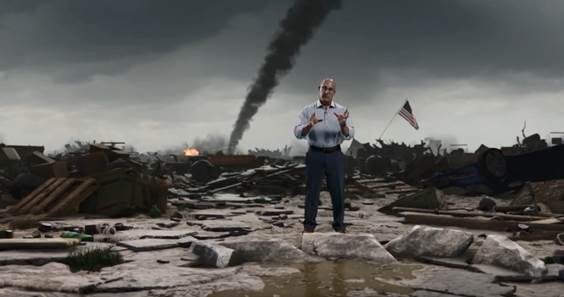The Weather Channel Launches IMR Technology Initiative

What started as a seemingly normal demonstration of a tornado’s power on The Weather Channel turned into anything but, as fallen power lines and flying debris seemed to invade the studio. Last Wednesday’s edition of flagship morning show “AMHQ” served as the network’s debut of its immersive mixed reality technology, allowing them to create a hyper-realistic tornado around meteorologist Jim Cantore.
The feat was accomplished thanks to Weather’s partnership with The Future Group, an augmented reality content and tech provider. Watching the on-air antics may have one imagining that the process took months and months to complete, but the partnership was only just announced on April 5.
“The overall production, from concept to narrative and script completion, was right at 60 days,” The Weather Channel vp of design Michael Potts told Cablefax. “And it was in parallel with our engineering and technology integration, bringing all of the equipment in-house.”
That integration included the onboarding of a graphical engine not typically seen in the office of a television network. The Future Group’s Frontier platform is powered by Unreal Engine, a suite of tools that is particularly popular in the video game industry.
The engine required some modification in order to handle the toll of IMR technology. Additional RAM and video processors gave it the much-needed boost, and from there it was down to design and creating the simulations. While Weather acted as the creative director, constructing the narrative and visualizing the story, The Future Group brought it to life.
Weather is going in full force in its commitment to IMR technology, planning on integrating its capabilities into 80% of broadcasts by 2020. Not all of the integrations will mimic the first, however.
“We want to evolve or revolutionize the way that weather presentation is done in general,” Potts said. “Weather presentation in general, across all broadcast medium, has been pretty traditional. What IMR is going to allow us to do is create environments so that we can become more personal and relevant to our everyday viewers. Rather than standing in a studio and indicating towards a map about a thunderstorm or what a temperature might be for a location, we can bring our audience with us, take our talent to a specific location… to talk about the current conditions, forecast the future conditions in a place that looks familiar.”
Moving towards that future and bringing the IMR to another level, the next logical step for Potts is to give Weather’s on-screen talent the power to control the scene and the environment being presented to the audience, “to give Jim Cantore or Stephanie Abrams the ability to change and modify the scenes and control the data.” Live integration of data will also be a work-in-progress for Weather, allowing for as precise a forecast as possible.
Don’t expect Weather to keep the technology to 2-D screens, or to one screen, either. Potts is already dreaming of how to use other devices to bring the viewer as close to experiencing natural events as possible.
“There’s plenty of opportunity in the future, once we have our scenes and environments created, to give our audience deeper glimpses and control into those environments or into the adjacent world,” Potts said. “You could be sitting on your couch at home watching this great presentation and, with a tap or swipe of your finger, you can broaden that world into your living room. Our devices can be extensions of our linear presentation, portals that you can control into places that you want to go.”